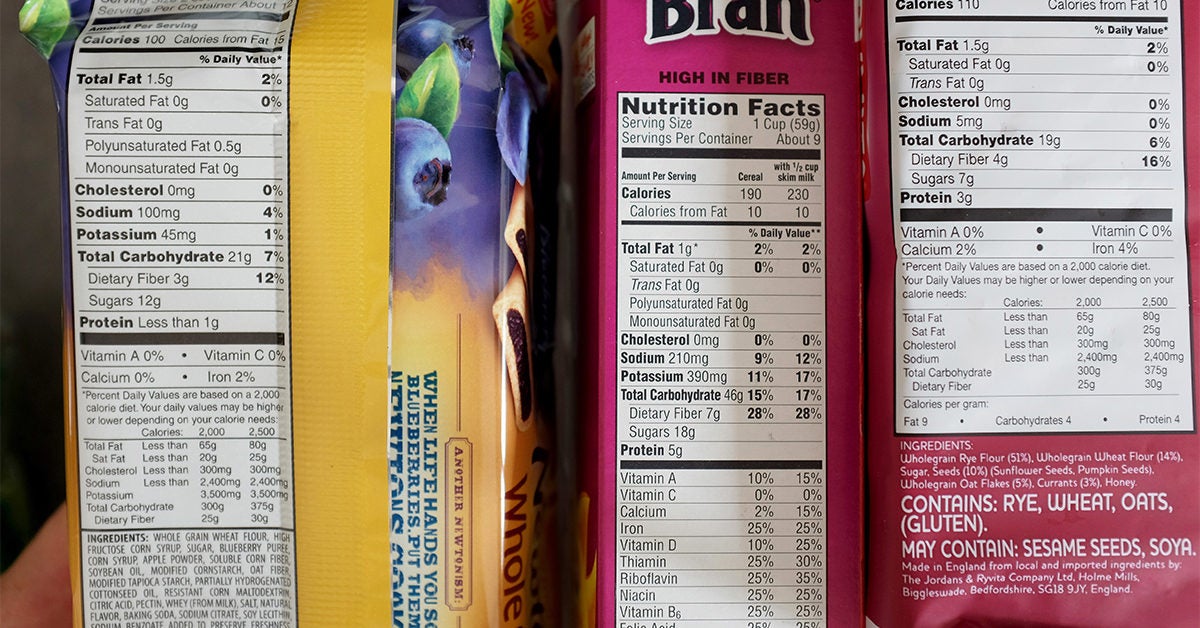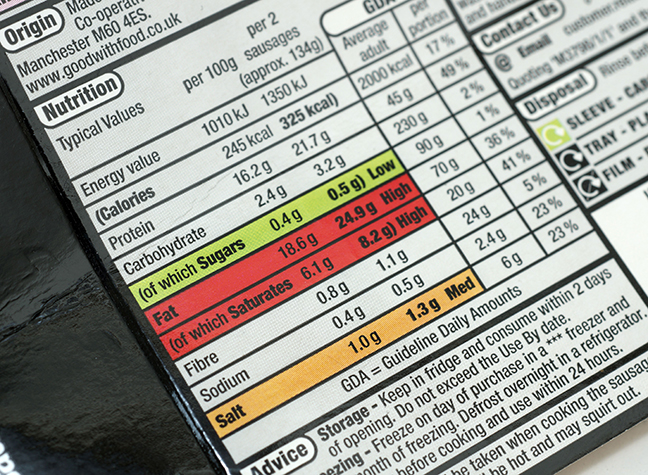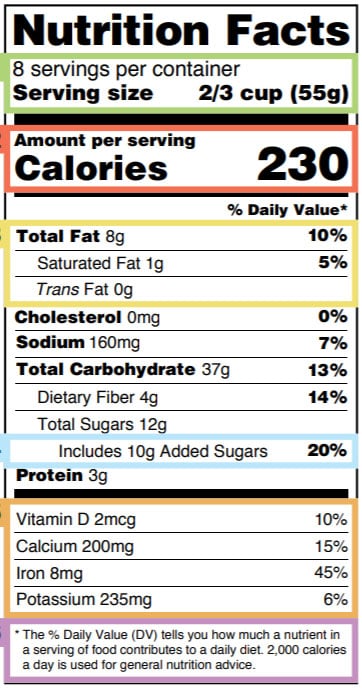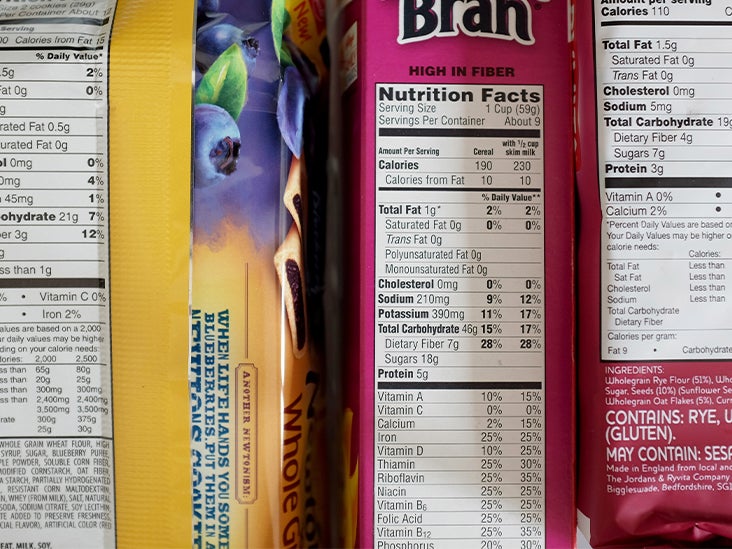44 reading sugar on food labels
Sugar Alcohols on Nutrition Labels - ReciPal Toggling sugar alcohols on a nutrition label. This is the vertical FDA example, but it's the same for other formats. In the Canadian formats it will automatically be toggled if sugar alcohols are more than 0 grams. ... He's read the FDA food labeling code countless times in the process of creating ReciPal and helping small food businesses with ... Understanding food labels - Action on Sugar HOW MUCH SUGAR IS IN YOUR FOOD/DRINK? Step 1 - Calculate amount of sugars per gram by dividing the amount of sugars per 100g OR 100ml by 100. Step 2 - Check the weight of a recommended portion as stated on the pack. Step 3 - Work out the amount of there is per portion by multiplying the figures from step 1 and 2.
How to Read Food Labels | mySugr Before reading the rest of the label, look at the serving size. The rest of the information — such as carbs, calories, sugars, fiber, and more — will be based on the serving size that's listed. Eating more than a serving size means you'll get more carbs, sugars, and calories than what's listed.

Reading sugar on food labels
How to Read Food Labels Without Being Tricked - Healthline Other added sugars: barley malt, molasses, cane juice crystals, lactose, corn sweetener, crystalline fructose, dextran, malt powder, ethyl maltol, fructose, fruit juice concentrate, galactose,... Learning To Read Labels :: Diabetes Education Online On a nutrition food label, subtract the fiber from the total carbohydrate amount. When you read food labels, the grams of sugar are already included in the total carbohydrate amount, so you do not need to count this sugar amount separately. The grams of sugar listed include both natural sugars, from fruit or milk, and added sugars. How To Read Food labels for Sugar | My Sugar Free Kitchen On the label check the sugars in the nutrition panel. 5g/ml or less of sugar per 100g/ml = this would count as low sugar content. It means 5% of the ingredients are sugar Between 5g/ml and 20g/ml of sugar per 100 grams = medium sugar content. With 20ml of sugar per 100 ml, this means the product is 20% sugar…not so good.
Reading sugar on food labels. How to Read Nutrition Labels for Sugar - hekagoodfoods The number of grams of sugar. Keep in mind, one gram of sugar is roughly equivalent to 1/4 teaspoon of sugar. A percentage indicating how much of your recommended daily intake the item contains. While this is helpful to reference, the FDA recommends natural and added sugars account for no more than 10% of your daily caloric intake. Understanding sugar content on food labels - Diabetes Care Community Understanding sugar content on food labels is important, to ensure that you're consuming healthy amounts. Reading the ingredient lists and nutrition facts tables on packaged foods is a helpful way for you to check what kind, and how much, sugar a product has. Finding sugar content in the ingredients list Food labels - NHS These labels provide information on the number of grams of fat, saturated fat, sugars and salt, and the amount of energy (in kJ and kcal) in a serving or portion of the food. But be aware that the manufacturer's idea of a portion may be different from yours. Some front-of-pack nutrition labels also provide information about reference intakes. How To Read Food Labels - myhdiet.com The way that manufacturers get around this is that any nutrient (including fat) that is less than 0.5 grams per serving can be labeled as "0 grams" . So, it looks like there's no fat, but in reality the entire serving is 100% fat, but because the serving size is so small in a cooking spray, the label can claim "0 grams" of fat.
Reading Food Labels When You Have Diabetes - WebMD Reduced cholesterol. At least 25% less cholesterol and 2 g or less of saturated fat. Calorie free. Less than 5 calories. Low calorie. 40 calories or less. Light or lite. 1/3 fewer calories or 50% ... Understanding food labels | Diabetes UK The labels show how many calories are in the food or drink and are also colour coded to show whether the food is low (green), medium (amber) or high (red) in fat, saturated fat, sugar and salt. The information on the front of the pack also tells you how the portion of the food contributes to the Reference Intake (RI) of an adult. How to understand food labels | Eat For Health All ingredients in a food product must be listed on the label in order (Food Labels - What do they mean? Food Standards Australia and New Zealand, from largest to smallest by weight. You can use this to spot foods that might be high in saturated fat, added salt or added sugars because these ingredients are listed in the top three. 5 ways to spot added sugars on food labels When reading the food labels, remember four grams of sugar is equal to one teaspoon. The American Heart Association recommends women consume no more than six teaspoons and men no more than nine teaspoons of sugar per day. 5. Read the label top to bottom Items on food labels are listed in order from largest to smallest quantity.
How to Read a Food Label to Make Sure It's Keto in 3 Easy Steps 1. Look for a brand that indicates "No Sugar Added". Read the ingredient list to verify. Pederson's brand with the No Sugar-Whole30 Approved seal is my personal choice. 2. Go to the butcher. You can find him in the grocery store by the meat section or at your local butcher shop. 13 Misleading Food Label Claims and How Not to Be Tricked - Sentient Media 1. Label Says "Sugar-Free". The Food and Drug Administration (FDA) provides guidelines for a variety of common food labels, including sugar-free. While the term suggests that products labeled this way would be completely free of sugar, they can actually contain up to 0.5 grams of sugar in a single serving size. How To Read Nutrition Labels - Mayo Clinic Diet 3. Check the % Daily Value. The % Daily Value (DV) tells you how much a nutrient in a serving of food contributes to a daily diet. 2,000 calories a day is used for general nutrition advice. Low is 5% or less. Aim for low in saturated fat, trans fat, cholesterol, sodium, and added sugars. High is 20% or more. Aim high in vitamins, minerals and ... Food Labels | CDC - Centers for Disease Control and Prevention Check the Serving size first. All the numbers on this label are for a 2/3-cup serving. This package has 8 servings. If you eat the whole thing, you are eating 8 times the amount of calories, carbs, fat, etc., shown on the label. Total Carbohydrate shows you types of carbs in the food, including sugar and fiber.
How To Read Food Labels | Prewellabs Read Food Labels - What the Glossy Front Label says! The packaging label on the front of any food item will have every claim that can persuade you to buy that item but don't get swayed by these. There will be a "low-calorie" version of your favourite cookies, and a "cholesterol-free" version of the sandwich spread.
Reading food labels: Tips if you have diabetes - Mayo Clinic Look for foods with 3 or more grams of fiber. Put sugar-free products in their place Sugar-free doesn't mean carbohydrate-free. Sugar-free foods may play a role in your diabetes diet, but remember that it's equally important to consider carbohydrates as well. A sugar-free label means that one serving has less than 0.5 grams of sugar.
Reading Food Labels | ADA - American Diabetes Association Put food labels to work. The Nutrition Facts labels on foods are really the key to making the best choices. We'll cover the basics so that these labels make shopping easier for you. You've heard it all. From carb-free to low-carb, to whole and empty carbs, it's hard to know what it all means. Blood sugar highs and lows aren't always ...
Added Sugars on the New Nutrition Facts Label | FDA Labels for foods and beverages with added sugars will list the number of grams and the percent Daily Value (%DV) for added sugars within the Nutrition Facts label. Having the word "includes"...
How To Read Food and Beverage Labels - National Institute on Aging Be on the lookout for terms that indicate added sugar, such as brown sugar, corn sweetener, corn syrup, dextrose, fructose, and high-fructose corn syrup. Artificial sweeteners such as sucralose, saccharin, aspartame, and acesulfame should also be consumed in moderation.
Sugars on food labels - Sugar Nutrition Resource Centre When we say 'sugar' we generally mean table sugar or sucrose. Sugar in the ingredients list is limited to this definition, plus a few derivative products. Other sugars added as ingredients are treated differently. The Food Standards Code specifies that other added sugars must be listed using their specific names in the ingredients list.
How to read labels for added sugar - That Sugar Movement One: Look for foods under 5g total sugar/100g In Australia, the Nutrition Information Panel (NIP) on the back of food and drink packaging lists total sugars content. It does not separate intrinsic sugars from added sugars. Yet, it is the added sugars - not those that are intrinsic or naturally-occurring in whole foods - that we are concerned with.
How to Understand and Use the Nutrition Facts Label | FDA It's important to realize that all the nutrient amounts shown on the label, including the number of calories, refer to the size of the serving. Pay attention to the serving size, especially how ...




Post a Comment for "44 reading sugar on food labels"